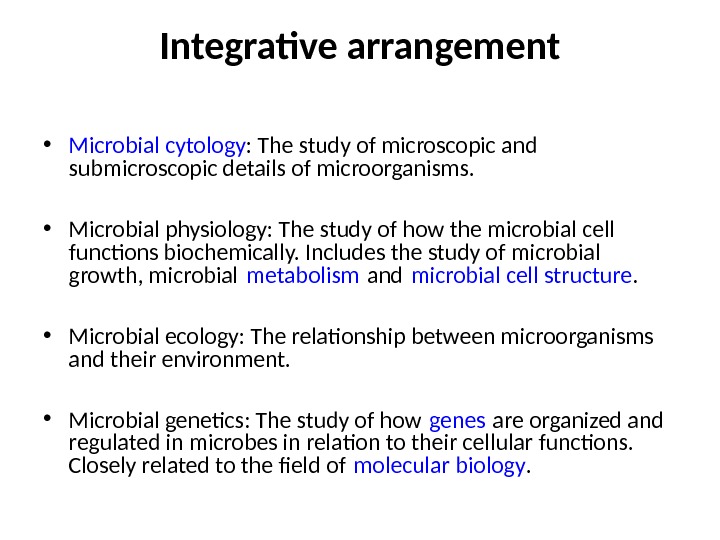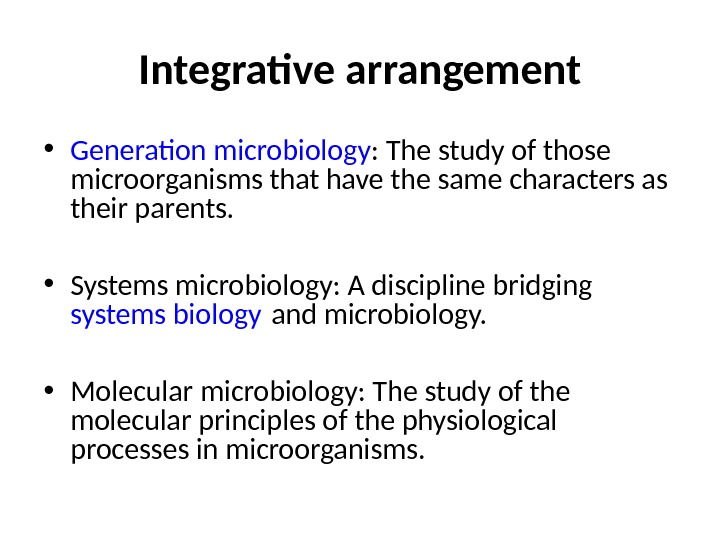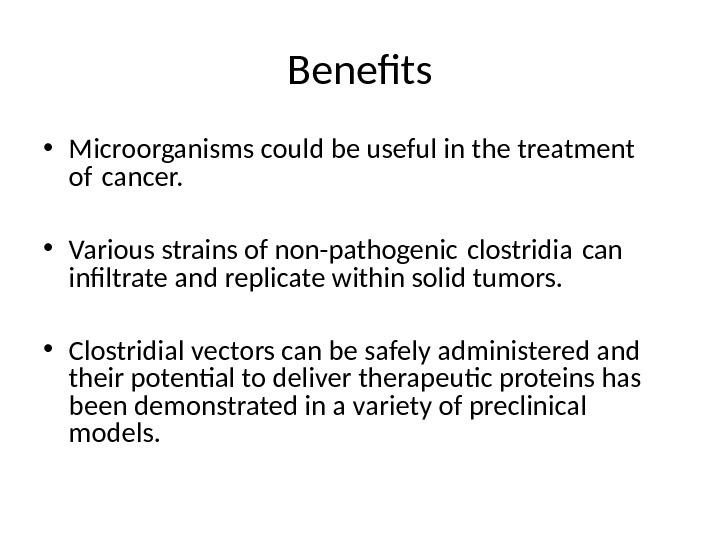Microbiology By Dr. Konrad T. Juszkiewicz, MD, MPH


















- Размер: 297.5 Кб
- Количество слайдов: 17
Описание презентации Microbiology By Dr. Konrad T. Juszkiewicz, MD, MPH по слайдам
 Microbiology By Dr. Konrad T. Juszkiewicz, MD, MPH
Microbiology By Dr. Konrad T. Juszkiewicz, MD, MPH
 Microbiology • From Greek μῑκρος, mīkros , «small” • βίος, bios , » life » • — λογία, — logia , study • Microbiology is the study of microscopic organisms , either – unicellular (single cell), – multicellular (cell colony), or – acellular (lacking cells) • Microbiology encompasses numerous sub-disciplines including : virology , mycology , parasitology , and bacteriology
Microbiology • From Greek μῑκρος, mīkros , «small” • βίος, bios , » life » • — λογία, — logia , study • Microbiology is the study of microscopic organisms , either – unicellular (single cell), – multicellular (cell colony), or – acellular (lacking cells) • Microbiology encompasses numerous sub-disciplines including : virology , mycology , parasitology , and bacteriology
 Taxonomic arrangement • Bacteriology : The study of bacteria. • Mycology: The study of fungi. • Protozoology: The study of protozoa. • Phycology (or algology): The study of algae.
Taxonomic arrangement • Bacteriology : The study of bacteria. • Mycology: The study of fungi. • Protozoology: The study of protozoa. • Phycology (or algology): The study of algae.
 Taxonomic arrangement • Parasitology : The study of parasites. • Immunology: The study of the immune system. • Virology: The study of viruses. • Nematology: The study of the nematodes • Microbiology: The study of microbes.
Taxonomic arrangement • Parasitology : The study of parasites. • Immunology: The study of the immune system. • Virology: The study of viruses. • Nematology: The study of the nematodes • Microbiology: The study of microbes.
 Integrative arrangement • Microbial cytology : The study of microscopic and submicroscopic details of microorganisms. • Microbial physiology: The study of how the microbial cell functions biochemically. Includes the study of microbial growth, microbial metabolism and microbial cell structure. • Microbial ecology: The relationship between microorganisms and their environment. • Microbial genetics: The study of how genes are organized and regulated in microbes in relation to their cellular functions. Closely related to the feld of molecular biology.
Integrative arrangement • Microbial cytology : The study of microscopic and submicroscopic details of microorganisms. • Microbial physiology: The study of how the microbial cell functions biochemically. Includes the study of microbial growth, microbial metabolism and microbial cell structure. • Microbial ecology: The relationship between microorganisms and their environment. • Microbial genetics: The study of how genes are organized and regulated in microbes in relation to their cellular functions. Closely related to the feld of molecular biology.
 Integrative arrangement • Cellular microbiology : A discipline bridging microbiology and cell biology. • Evolutionary microbiology: The study of the evolution of microbes. This feld can be subdivided into: – Microbial taxonomy : The naming and classifcation of microorganisms. – Microbial systematics : The study of the diversity and genetic relationship of microorganisms.
Integrative arrangement • Cellular microbiology : A discipline bridging microbiology and cell biology. • Evolutionary microbiology: The study of the evolution of microbes. This feld can be subdivided into: – Microbial taxonomy : The naming and classifcation of microorganisms. – Microbial systematics : The study of the diversity and genetic relationship of microorganisms.
 Integrative arrangement • Generation microbiology : The study of those microorganisms that have the same characters as their parents. • Systems microbiology: A discipline bridging systems biology and microbiology. • Molecular microbiology: The study of the molecular principles of the physiological processes in microorganisms.
Integrative arrangement • Generation microbiology : The study of those microorganisms that have the same characters as their parents. • Systems microbiology: A discipline bridging systems biology and microbiology. • Molecular microbiology: The study of the molecular principles of the physiological processes in microorganisms.
 Other • Nano microbiology : The study of those organisms on nano level. • Exo microbiology (or Astro microbiology ): The study of microorganisms in outer space • Biological agent: The study of those microorganisms which are being used in weapon industries.
Other • Nano microbiology : The study of those organisms on nano level. • Exo microbiology (or Astro microbiology ): The study of microorganisms in outer space • Biological agent: The study of those microorganisms which are being used in weapon industries.
 Applied microbiology • Medical microbiology : The study of the pathogenic microbes and the role of microbes in human illness. Includes the study of : – microbial pathogenesis – Epidemiology • Related to the study of disease pathology and immunology. • Pharmaceutical microbiology: The study of microorganisms that are related to the production of antibiotics, enzymes, vitamins, vaccines, and other pharmaceutical products and that cause pharmaceutical contamination and spoil. • Industrial microbiology: The exploitation of microbes for use in industrial processes. – industrial fermentation – wastewater treatment. • Closely linked to the biotechnology industry. This feld also includes brewing , an important application of microbiology.
Applied microbiology • Medical microbiology : The study of the pathogenic microbes and the role of microbes in human illness. Includes the study of : – microbial pathogenesis – Epidemiology • Related to the study of disease pathology and immunology. • Pharmaceutical microbiology: The study of microorganisms that are related to the production of antibiotics, enzymes, vitamins, vaccines, and other pharmaceutical products and that cause pharmaceutical contamination and spoil. • Industrial microbiology: The exploitation of microbes for use in industrial processes. – industrial fermentation – wastewater treatment. • Closely linked to the biotechnology industry. This feld also includes brewing , an important application of microbiology.
 Applied microbiology • Microbial biotechnology : The manipulation of microorganisms at the genetic and molecular level to generate useful products. • Food microbiology: The study of microorganisms causing food spoilage and foodborne illness. Using microorganisms to produce foods, for example by fermentation. • Agricultural microbiology: The study of agriculturally relevant microorganisms. This feld can be further classifed into the following: – Plant microbiology and Plant pathology : The study of the interactions between microorganisms and plant pathogens. – Soil microbiology : The study of those microorganisms that are found in soil.
Applied microbiology • Microbial biotechnology : The manipulation of microorganisms at the genetic and molecular level to generate useful products. • Food microbiology: The study of microorganisms causing food spoilage and foodborne illness. Using microorganisms to produce foods, for example by fermentation. • Agricultural microbiology: The study of agriculturally relevant microorganisms. This feld can be further classifed into the following: – Plant microbiology and Plant pathology : The study of the interactions between microorganisms and plant pathogens. – Soil microbiology : The study of those microorganisms that are found in soil.
 Applied microbiology • Veterinary microbiology : The study of the role of microbes in veterinary medicine or animal taxonomy. • Water microbiology (or Aquatic microbiology): The study of those microorganisms that are found in water. • Aeromicrobiology (or Air microbiology): The study of airborne microorganisms.
Applied microbiology • Veterinary microbiology : The study of the role of microbes in veterinary medicine or animal taxonomy. • Water microbiology (or Aquatic microbiology): The study of those microorganisms that are found in water. • Aeromicrobiology (or Air microbiology): The study of airborne microorganisms.
 Applied microbiology • Environmental microbiology : The study of the function and diversity of microbes in their natural environments. • This involves the characterization of key bacterial habitats such as the rhizosphere and phyllosphere , soil and groundwater ecosys-tems , open oceans or extreme environments ( extremophiles ). • This feld includes other branches of microbiology such as: – Microbial ecology – Microbially mediated nutrient cycling – Geomicrobiology – Microbial diversity – Bioremediation
Applied microbiology • Environmental microbiology : The study of the function and diversity of microbes in their natural environments. • This involves the characterization of key bacterial habitats such as the rhizosphere and phyllosphere , soil and groundwater ecosys-tems , open oceans or extreme environments ( extremophiles ). • This feld includes other branches of microbiology such as: – Microbial ecology – Microbially mediated nutrient cycling – Geomicrobiology – Microbial diversity – Bioremediation
 Benefts • We fear microbes due to the association of some microbes with various human illnesses, • Microbes responsible for numerous benefcial processes such as – industrial fermentation (e. g. the production of alcohol , vinegar and dairy products ), – Antibiotic production – As vehicles for cloning in more complex organisms such as plants. • Knowledge of microbes to produce biotechnologically important enzymes such as Taq polymerase , reporter genes for use in other genetic systems and novel molecular biology techniques such as the yeast two-hybrid system.
Benefts • We fear microbes due to the association of some microbes with various human illnesses, • Microbes responsible for numerous benefcial processes such as – industrial fermentation (e. g. the production of alcohol , vinegar and dairy products ), – Antibiotic production – As vehicles for cloning in more complex organisms such as plants. • Knowledge of microbes to produce biotechnologically important enzymes such as Taq polymerase , reporter genes for use in other genetic systems and novel molecular biology techniques such as the yeast two-hybrid system.
 Benefts The industrial production of amino acids • Corynebacterium glutamicum : bacterial species with an annual production of more than two million tons of amino acids, mainly L-glutamate and L-lysine • A variety of biopolymers , such as polysaccharides , polyesters , and polyamides , are produced by microorganisms • Biotechnological production of biopolymers with tailored properties suitable for high-value medical application such as tissue engineering and drug delivery. • The biosynthesis of xanthan , alginate , cellulose , cyanophycin , poly(gamma-glutamic acid), levan , hyaluronic acid , organic acids, oligosaccharides and polysaccharide , and polyhydroxyalkanoates
Benefts The industrial production of amino acids • Corynebacterium glutamicum : bacterial species with an annual production of more than two million tons of amino acids, mainly L-glutamate and L-lysine • A variety of biopolymers , such as polysaccharides , polyesters , and polyamides , are produced by microorganisms • Biotechnological production of biopolymers with tailored properties suitable for high-value medical application such as tissue engineering and drug delivery. • The biosynthesis of xanthan , alginate , cellulose , cyanophycin , poly(gamma-glutamic acid), levan , hyaluronic acid , organic acids, oligosaccharides and polysaccharide , and polyhydroxyalkanoates
 Benefts • Microorganisms benefcial for microbial biodegradation or bioremediation of domestic, agricultural and industrial wastes and subsurface pollution in soils, sediments and marine environments. • The ability of each microorganism to degrade toxic waste depends on the nature of each contaminant. • Since sites typically have multiple pollutant types, the most efective approach to microbial biodegradation is to use a mixture of bacterial and fungal species and strains, each specifc to the biodegradation of one or more types of contaminants
Benefts • Microorganisms benefcial for microbial biodegradation or bioremediation of domestic, agricultural and industrial wastes and subsurface pollution in soils, sediments and marine environments. • The ability of each microorganism to degrade toxic waste depends on the nature of each contaminant. • Since sites typically have multiple pollutant types, the most efective approach to microbial biodegradation is to use a mixture of bacterial and fungal species and strains, each specifc to the biodegradation of one or more types of contaminants
 Benefts • Symbiotic microbial communities are known to confer various benefts to their human and animal hosts health including – aiding digestion, – production of benefcial vitamins and amino acids, and – suppression of pathogenic microbes. • Some beneft may be conferred by consuming fermented foods, probiotics (bacteria potentially benefcial to the digestive system) and/or prebiotics (substances consumed to promote the growth of probiotic microorganisms). • The ways the microbiome influences human and animal health, as well as methods to influence the microbiome are active areas of research.
Benefts • Symbiotic microbial communities are known to confer various benefts to their human and animal hosts health including – aiding digestion, – production of benefcial vitamins and amino acids, and – suppression of pathogenic microbes. • Some beneft may be conferred by consuming fermented foods, probiotics (bacteria potentially benefcial to the digestive system) and/or prebiotics (substances consumed to promote the growth of probiotic microorganisms). • The ways the microbiome influences human and animal health, as well as methods to influence the microbiome are active areas of research.
 Benefts • Microorganisms could be useful in the treatment of cancer. • Various strains of non-pathogenic clostridia can infltrate and replicate within solid tumors. • Clostridial vectors can be safely administered and their potential to deliver therapeutic proteins has been demonstrated in a variety of preclinical models.
Benefts • Microorganisms could be useful in the treatment of cancer. • Various strains of non-pathogenic clostridia can infltrate and replicate within solid tumors. • Clostridial vectors can be safely administered and their potential to deliver therapeutic proteins has been demonstrated in a variety of preclinical models.

